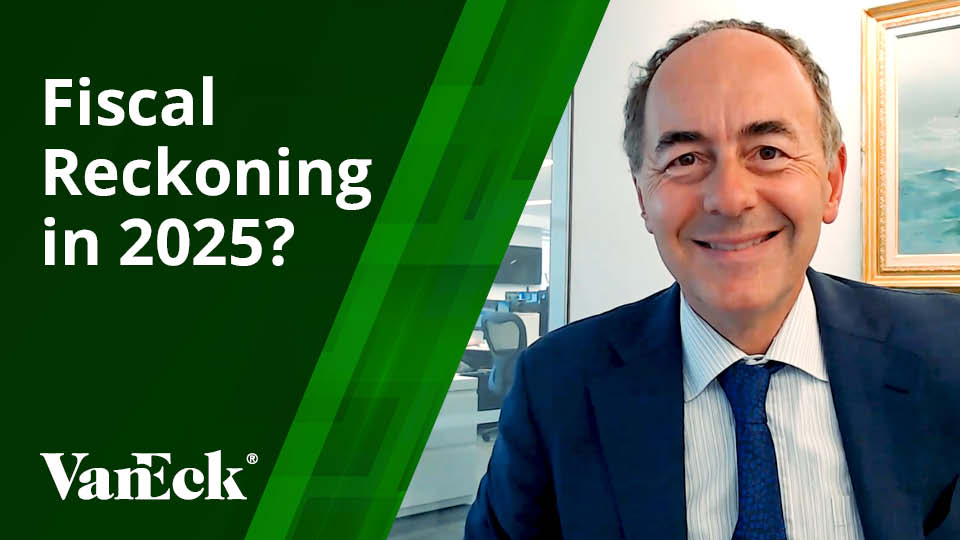2024 Macro Predictions: Sideways 2.0
February 08, 2024
Read Time 4 MIN
Dear Fellow Investors,
Our outlook for financial markets in 2023 was “sideways” and “40/60,” or overweight bonds. This strategy worked well until November 2023, when the market suddenly rallied aggressively and priced in Federal Reserve (Fed) interest rate cuts, which were expected to happen in 2024. It is one of the wonders of the market that it can price in its view of the future so quickly.
In this sense, it could be that 2024 has already happened. One could imagine that the three macro factors—monetary policy, government spending and global economic growth—will not change much in 2024. Let’s review those three major forces on markets, as well as some risks and trends worth noting.
Monetary Policy: Not Very Stimulative
To recap this cycle: stocks and bonds historically do not perform well when the Fed tightens monetary conditions, and that’s just what the Fed announced it would be doing at the end of 2021. This would include raising rates and changing its balance sheet actions, which doesn’t create a great environment for financial assets.
A second, modern component to monetary policy is the Fed balance sheet. After buying bonds during the pandemic, the Fed has now started shrinking the balance sheet—from a high of almost $9T in early 2022, assets dropped to $7.8T toward the end of December 2023.1
Our favorite inflation is wage inflation, not food or gas prices. This is the kind of inflation that is endemic and hard to manage once it takes hold. And wage inflation is above 4%, not near the Fed’s 2% target, so we don’t see a big Fed stimulus. And the silent Fed action of reducing its bond holdings (“quantitative tightening”), continues.
Government Spending: Also Muted
A second bearish factor is that government spending is unlikely to increase next year. The Republicans, in control of the House of Representatives, continue to look to slow government spending. While we probably didn’t sufficiently appreciate the amount of some of the Biden Administration’s spending, like with the environmental IRA act, any such upside surprises are very unlikely in 2024.
Global Growth at Low Levels
Over the last 20 years, the U.S. and China have been the two main pillars of global growth. But while there are bright spots, China is remarkable now for its economic weakness. The property market recession has helped pull Chinese prices lower year over year, and that deflationary force affects the world economy. Other centers of growth like India, Indonesia and Africa, are not big enough yet to drive global growth.
Notable Opportunities for 2024
- Bonds: While interest rates whipsawed investors in 2023 with a net positive result, our outlook favoring bonds hasn’t changed. They offer attractive risk-adjusted returns compared to equities given the headwinds discussed above. After the 2022 and 2023 losses, bond investments are now offering attractive yields. This has been our favorite asset class to buy and remains our preference. (See What to Buy? Bonds. When? Now.) As a reference, bonds offered attractive total returns in the 1970s, even though that decade was the worst for interest rates in the last 100 years.
- Yield curve: We like to look for market distortions, and the most notable one is “yield curve inversion”—long-term interest rates being lower than short-term rates. If, and it’s a big “if”, government entities like the Fed are stepping back from the bond markets, then it makes sense for long-term rates to be higher, because with greater risk should come greater return. Yield curve inversion is present only about 10% of the time. It’s unusual.
- India/emerging markets: With the newfound ubiquity and affordability of mobile phones in India, the internet sector there is well primed to do as well as it has in the U.S., China, and other major markets. Digital India seems like a good tactical play, despite higher price/earnings ratios. Emerging markets in general have lagged for so many years that most investors have given up. So many, that 2024 may be their year. (Please note that India is a multi-year trend and that we are most bullish Brazil/LatAm in our active funds as of the date of this letter.)
- Stores of value/real assets: In March 2023, I “pounded the table” on gold and bitcoin in a CNBC interview While those assets have rallied hard since then—again, the market likes to anticipate!—I don’t think this trend is over.
- Value stocks: Growth stocks had a shockingly good 2023. Stocks in banks and financials have been beaten up. They are definitely worth a close look. This outlook is discussed in a recent podcast, The Compound and Friends, Episode 113, released on October 13, 2023.
One thing missing above is that the U.S. economy and its labor market are near perfection. Now, profit growth is returning for the big technology stocks and the market overall, giving the stock market a life. Be invested!
Sincerely,
Jan
To receive more Investment Outlook insights, sign up in our subscription center.
Related Topics
Related Insights
April 17, 2024
December 19, 2023
IMPORTANT DISCLOSURES
1 U.S. Federal Reserve: FEDERAL RESERVE Statistical Release, December 28, 2023.
Coin Definitions
Bitcoin (BTC) is a decentralized digital currency, without a central bank or single administrator, that can be sent from user to user on the peer-to-peer bitcoin network without the need for intermediaries.
Please note that VanEck may offer investments products that invest in the asset class(es) or industries included herein.
This is not an offer to buy or sell, or a recommendation to buy or sell any of the securities, financial instruments or digital assets mentioned herein. The information presented does not involve the rendering of personalized investment, financial, legal, tax advice, or any call to action. Certain statements contained herein may constitute projections, forecasts and other forward-looking statements, which do not reflect actual results, are for illustrative purposes only, are valid as of the date of this communication, and are subject to change without notice. Actual future performance of any assets or industries mentioned are unknown. Information provided by third party sources are believed to be reliable and have not been independently verified for accuracy or completeness and cannot be guaranteed. VanEck does not guarantee the accuracy of third party data. The information herein represents the opinion of the author(s), but not necessarily those of VanEck or its other employees.
Index performance is not illustrative of fund performance. It is not possible to invest directly in an index.
Emerging Market securities are subject to greater risks than U.S. domestic investments. These additional risks may include exchange rate fluctuations and exchange controls; less publicly available information; more volatile or less liquid securities markets; and the possibility of arbitrary action by foreign governments, or political, economic or social instability.
Investments in digital assets and Web3 companies are highly speculative and involve a high degree of risk. These risks include, but are not limited to: the technology is new and many of its uses may be untested; intense competition; slow adoption rates and the potential for product obsolescence; volatility and limited liquidity, including but not limited to, inability to liquidate a position; loss or destruction of key(s) to access accounts or the blockchain; reliance on digital wallets; reliance on unregulated markets and exchanges; reliance on the internet; cybersecurity risks; and the lack of regulation and the potential for new laws and regulation that may be difficult to predict. Moreover, the extent to which Web3 companies or digital assets utilize blockchain technology may vary, and it is possible that even widespread adoption of blockchain technology may not result in a material increase in the value of such companies or digital assets.
Digital asset prices are highly volatile, and the value of digital assets, and the companies that invest in them, can rise or fall dramatically and quickly. If their value goes down, there’s no guarantee that it will rise again. As a result, there is a significant risk of loss of your entire principal investment.
Digital assets are not generally backed or supported by any government or central bank and are not covered by FDIC or SIPC insurance. Accounts at digital asset custodians and exchanges are not protected by SPIC and are not FDIC insured. Furthermore, markets and exchanges for digital assets are not regulated with the same controls or customer protections available in traditional equity, option, futures, or foreign exchange investing.
Digital assets include, but are not limited to, cryptocurrencies, tokens, NFTs, assets stored or created using blockchain technology, and other Web3 products.
Web3 Companies include but are not limited to, companies that involve the development, innovation, and/or utilization of blockchain, digital assets, or crypto technologies.
All investing is subject to risk, including the possible loss of the money you invest. As with any investment strategy, there is no guarantee that investment objectives will be met and investors may lose money. Diversification does not ensure a profit or protect against a loss in a declining market. Past performance is no guarantee of future results.
© Van Eck Securities Corporation, Distributor, a wholly owned subsidiary of Van Eck Associates Corporation.
IMPORTANT DISCLOSURES
1 U.S. Federal Reserve: FEDERAL RESERVE Statistical Release, December 28, 2023.
Coin Definitions
Bitcoin (BTC) is a decentralized digital currency, without a central bank or single administrator, that can be sent from user to user on the peer-to-peer bitcoin network without the need for intermediaries.
Please note that VanEck may offer investments products that invest in the asset class(es) or industries included herein.
This is not an offer to buy or sell, or a recommendation to buy or sell any of the securities, financial instruments or digital assets mentioned herein. The information presented does not involve the rendering of personalized investment, financial, legal, tax advice, or any call to action. Certain statements contained herein may constitute projections, forecasts and other forward-looking statements, which do not reflect actual results, are for illustrative purposes only, are valid as of the date of this communication, and are subject to change without notice. Actual future performance of any assets or industries mentioned are unknown. Information provided by third party sources are believed to be reliable and have not been independently verified for accuracy or completeness and cannot be guaranteed. VanEck does not guarantee the accuracy of third party data. The information herein represents the opinion of the author(s), but not necessarily those of VanEck or its other employees.
Index performance is not illustrative of fund performance. It is not possible to invest directly in an index.
Emerging Market securities are subject to greater risks than U.S. domestic investments. These additional risks may include exchange rate fluctuations and exchange controls; less publicly available information; more volatile or less liquid securities markets; and the possibility of arbitrary action by foreign governments, or political, economic or social instability.
Investments in digital assets and Web3 companies are highly speculative and involve a high degree of risk. These risks include, but are not limited to: the technology is new and many of its uses may be untested; intense competition; slow adoption rates and the potential for product obsolescence; volatility and limited liquidity, including but not limited to, inability to liquidate a position; loss or destruction of key(s) to access accounts or the blockchain; reliance on digital wallets; reliance on unregulated markets and exchanges; reliance on the internet; cybersecurity risks; and the lack of regulation and the potential for new laws and regulation that may be difficult to predict. Moreover, the extent to which Web3 companies or digital assets utilize blockchain technology may vary, and it is possible that even widespread adoption of blockchain technology may not result in a material increase in the value of such companies or digital assets.
Digital asset prices are highly volatile, and the value of digital assets, and the companies that invest in them, can rise or fall dramatically and quickly. If their value goes down, there’s no guarantee that it will rise again. As a result, there is a significant risk of loss of your entire principal investment.
Digital assets are not generally backed or supported by any government or central bank and are not covered by FDIC or SIPC insurance. Accounts at digital asset custodians and exchanges are not protected by SPIC and are not FDIC insured. Furthermore, markets and exchanges for digital assets are not regulated with the same controls or customer protections available in traditional equity, option, futures, or foreign exchange investing.
Digital assets include, but are not limited to, cryptocurrencies, tokens, NFTs, assets stored or created using blockchain technology, and other Web3 products.
Web3 Companies include but are not limited to, companies that involve the development, innovation, and/or utilization of blockchain, digital assets, or crypto technologies.
All investing is subject to risk, including the possible loss of the money you invest. As with any investment strategy, there is no guarantee that investment objectives will be met and investors may lose money. Diversification does not ensure a profit or protect against a loss in a declining market. Past performance is no guarantee of future results.
© Van Eck Securities Corporation, Distributor, a wholly owned subsidiary of Van Eck Associates Corporation.



